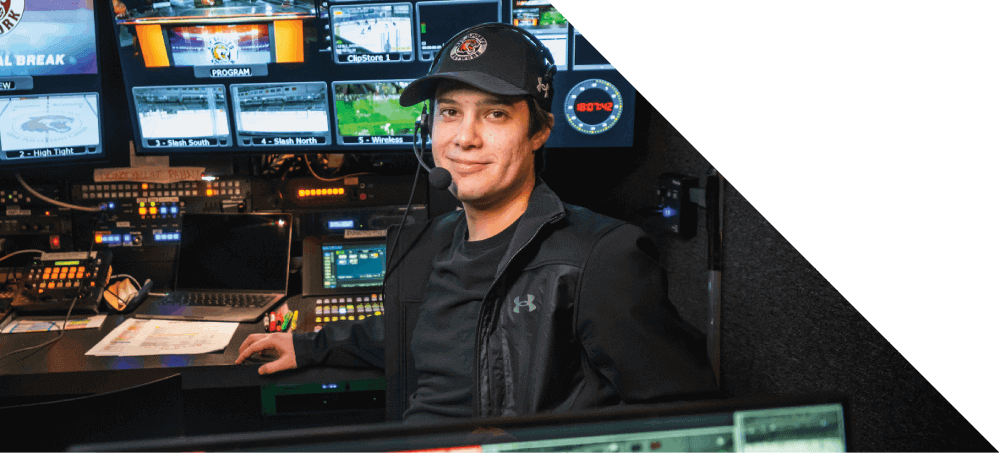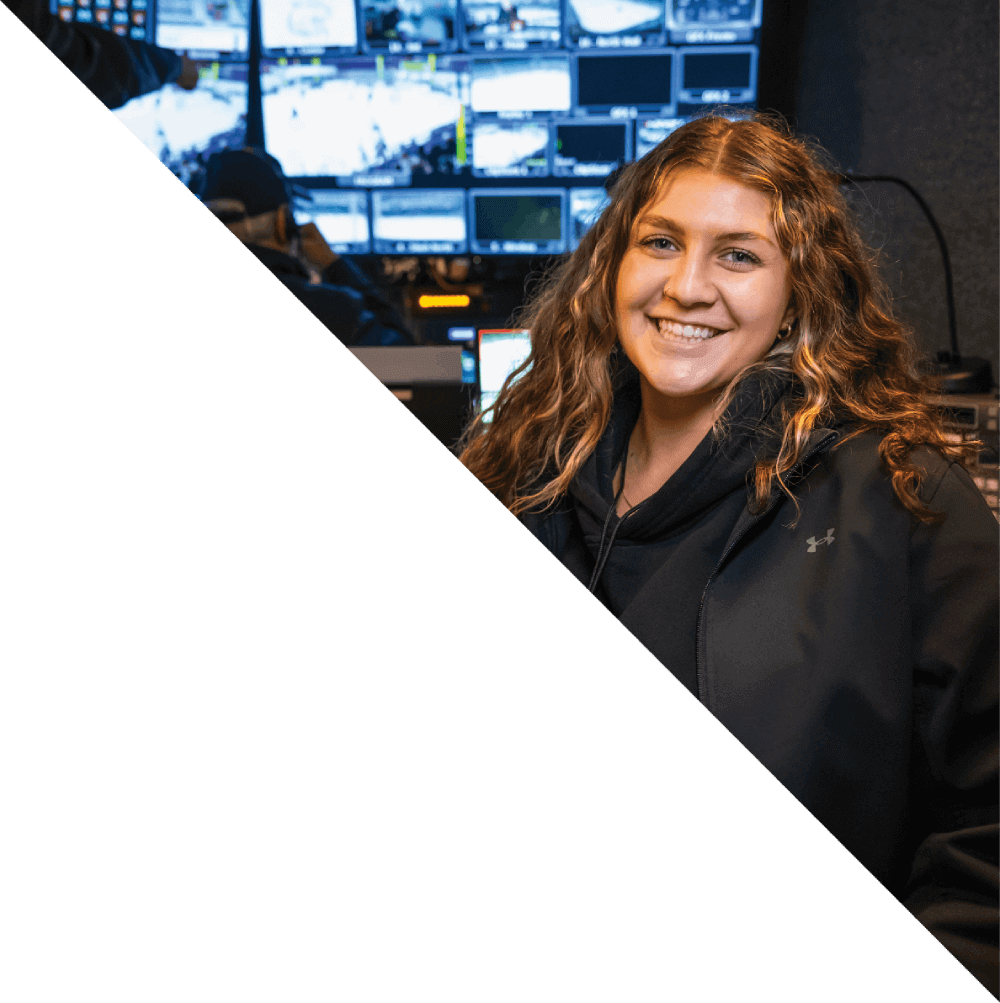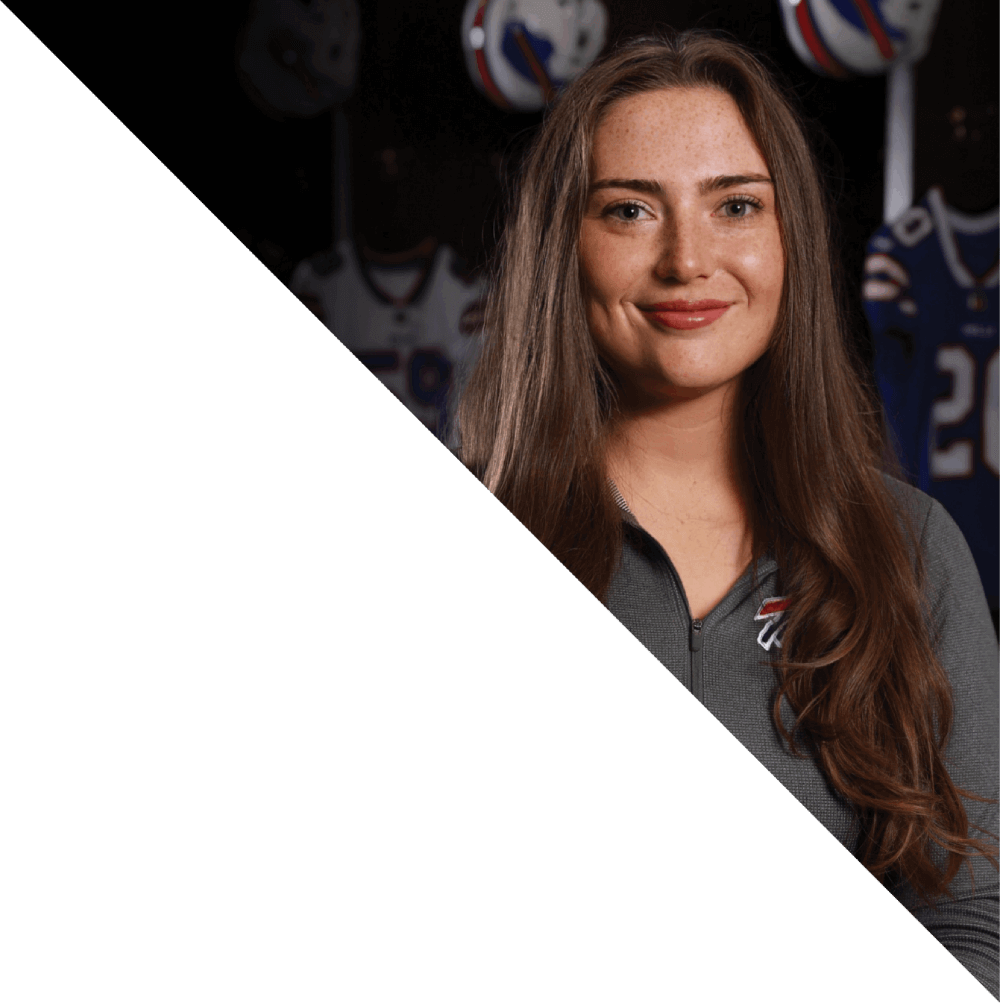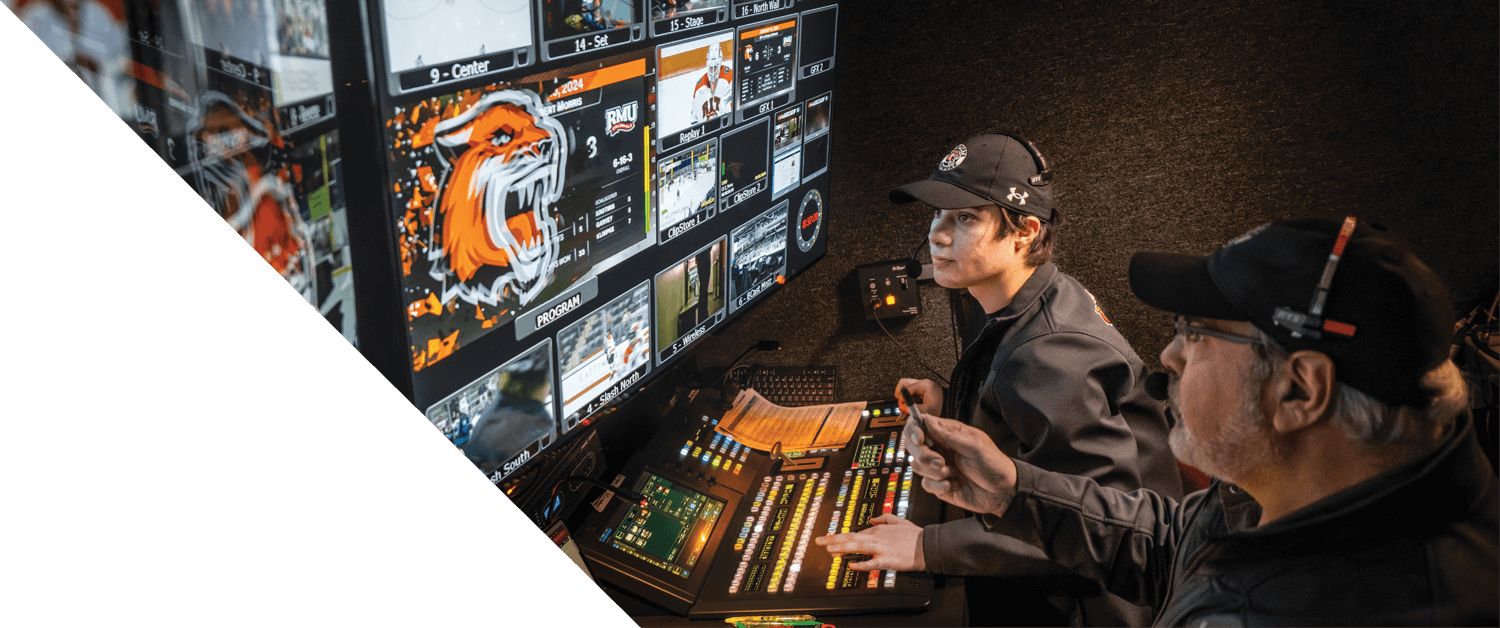Students score with RIT Sports Network

Photos by Traci Westcott
It’s a Friday night on RIT’s campus.
People are starting to stream into an icy arena in their orange and black, ready to cheer on the Tigers’ nationally ranked men’s hockey team. Hours before the puck drops, the action is intense.
Cameras are zooming in and out, video boards are sliding through graphics, on-air talent is speaking, the teleprompter is rolling, music is blasting, and multiple screens are displaying views from every corner of the arena. While the athletes and coaches prepare to compete, another crew prepares for its show. Behind all the action on the ice, RIT Sports Network is readying for its own performance.


Central to the production is Lexie Mancuso, a fourth-year graphic design student. She is surrounded by other students from different majors who are all filling roles, whether it be in-house replay, broadcast graphics, or running a rink-side camera.
Mancuso has grown in her few years with Sports Network and now holds a student manager role. Although she didn’t intend to work in sports as a career, her experiences with Sports Network have sent her down that path. She hopes to land a job working in football in the future.
“It’s not something I thought I would end up loving and working in,” said Mancuso, who is from Spencerport, N.Y. “Sports Network gave me the opportunity, and it’s a really cool thing to take away from college, finding this passion that I didn’t know I had before.”
Another student busy preparing for the game is Vlad Simion, originally from Bucharest, Romania. Unlike Mancuso, Simion—who graduated with a degree in motion picture science in 2020 and is back at RIT working on a master’s degree in color science—has no intention of working in sports.
Simion has already landed a job with the Los Angeles-based virtual production and effects company Lux Machina. Now an associate color scientist with the firm, he has contributed to Barbie, Masters of the Air, and House of the Dragon, among other media.
After hearing about student job opportunities with Sports Network from classmates, Simion got involved. He began helping with the in-house production, and since then has filled roles as replay operator, camera operator, technical director, director of video operations, and more. Despite not having an interest in sports, Simion has gained valuable knowledge that has helped him in his career.
“I knew I wanted to work on high-profile productions and all the impressive technologies that we use in media,” said Simion. “Sports Network was an avenue that I enjoyed and I knew would help me in my professional life and my life as a student.”
RIT Sports Network, or SportsZone (as it was called at the time), started in 2002 when RIT Senior Vice President and Treasurer James Watters was looking for ways to increase student experience and engagement. Knowing the impact athletics has on a campus’s pulse, he had the idea to start a production company to broadcast sporting events.
Watters reached out to RIT alumnus Sean Bratches ’91 (business administration), who was a chief marketing officer for ESPN at the time. With Bratches’ advice and connections, Watters put together the equipment and talent needed to get SportsZone off the ground, including Assistant Director Mark Fragale and Executive Director for University Production Services Steven Wunrow.
The program, with ESPN’s backing, was given local cable air time for the 30-minute news magazine-style sports show, highlighting all RIT sports.
“It was set up by ESPN to give local Division III sports more exposure in their local market,” explained Fragale.
400+
hours of on-air time per year
1.2k+
student employees since 2002
30k+
viewers for Tiger hockey every year
135+
Division III streaming broadcasts each year
44k+
viewers of Division III streaming broadcasts
40+
Division I women’s and men’s ice hockey broadcasts each year
As years went by, SportsZone needed a refresh. Soon, the group started broadcasting live hockey games and streaming the school’s other sports. Today, Sports Network airs more than 100 athletic contests throughout the academic year, with fully produced live broadcasts of Tigers’ men’s and women’s hockey and streaming of more than a dozen of RIT’s Division III sports, which is led by producer, director, and editor Kevin Roche.
In addition to what those watching from home might see, Sports Network’s Rachel Conidaris—also a producer, editor, and director—leads the content for the in-game production, which includes player headshots, behind-the-scenes videos, graphics, promotions, and all other content that is viewed on the video boards in the Gene Polisseni Center during games.
No matter what changes have come along in the more than two decades of RIT Sports Network, the heart of the organization has always been student experience.
Approximately 65 students are hired every year to help with production and editing. Student workers come from a variety of backgrounds and are able to take their skills with them into future careers. It’s not just technical and broadcast-specific skills students involved with Sports Network walk away with. Soft skills, such as leadership and communication, are developed that help no matter what industry a student plans to enter after college.
“I’ve learned a lot of teamwork and collaboration skills,” said Mancuso. “Developing those skills translates to every aspect of life, every job.”


Vlad Simion, left, and Lexie Mancuso, right, took classroom knowledge and expanded it with professional experience through RIT Sports Network, setting themselves up for bright futures in production.
Simion credits his Sports Network experience with getting him ready to enter a professional environment and being able to deal with the pressures that come with it.
“You get exposed to all the things that you will encounter later in life,” said Simion. “It’s a good place where you can prepare for that. Even if you’re not going to go into broadcasting, it teaches you a lot of good lessons.”
The main initiative of RIT Sports Network from the onset was to raise awareness of athletics and enhance student experience. Both have been accomplished year after year.
“There are a tremendous amount of success stories from the students who have worked for it,” said Watters. “It helps to elevate the interest of sports on campus. And it is a good recognition for a lot of student-athletes we have featured and celebrated.”
It is unknown what technology and college athletics will look like in the future, but it is clear that Sports Network will remain a prominent and integral part of RIT’s fabric, evolving with the times but remaining constant in its ability to provide students with valuable experience.
“The worlds of business, technology, and sport are inextricably intertwined,” said Bratches, who also held a leadership role at Formula 1 and now works in the private equity space. “And the on-campus introduction of the SportsZone brand fostered a community and service, and permitted students both behind and in front of the camera to leverage their in-classroom learnings to a real-world application, while standing to serve the RIT community passionate about their Tiger sports.”
Alumni experiences
Many RIT graduates have gone on to great heights after earlier years with SportsZone—now known as RIT Sports Network.
Story by Rich Kiley

Photo by Bill Wippert
Shannon Brown ’22
Bills and Sabres director
It’s difficult to put a title on the many roles she plays for NFL and NHL teams, but you could call Shannon Brown ’22 (film and animation) a digital designer/technical director extraordinaire.
For the Buffalo Bills, Brown does everything from video editing, instant replays, and graphic design to motion graphics for social media and broadcast programming. In addition to creating hype videos and show opens for the defending AFC East football champs, she edits key elements for podcasts and player interviews and also serves as technical director on live shows.
For the Buffalo Sabres, she serves as technical director for pregame, intermission, and postgame programming for Sabres Game Night on the MSG cable network, among other roles.
Patrick Church ’12
Behind-the-scenes lessons
As an audio technician in the early days of SportsZone, Patrick Church ’12 (mechanical engineering technology) initially worked the live men’s hockey broadcasts, thanks to his job with RIT Tech Crew. While on a co-op with SportsZone, he designed, built, and installed the overhead goal cameras inside Ritter Arena.
Working live broadcasts, Church was given many responsibilities for setup, operation, and teardown. Under the pressure of live TV, he learned the importance of effective communication, how to delegate and manage others, and to be accountable—skills he carried into his current role as a supplier quality technical advisor at Cummins Inc.
“I felt lucky to be a part of the live broadcasts from the beginning,” Church recalled. “Everyone was learning day by day, and we built something incredible.”
Andrzej Lubaszka ’12
Team building
Andrzej Lubaszka ’09 (electrical engineering) is a chief technologist at Analog Way, serving as a key link between the product development team and the sales and support units and customers who employ the France-based company’s video processing products.
At RIT, he was part of the team that built SportsZone’s original live truck/trailer still in use today. Getting the truck/trailer up and running in such a short timeframe is still a highlight of his career, said Lubaszka.
“SportsZone employs a staff team that has come from deep industry experiences before joining RIT,” he said. “It has allowed a very professional culture to develop, while still allowing space for students to grow and learn.”
Jesse James ’12
Championship experiences
Currently a swing video editor for Colorado-based Wave Sports and Entertainment, Jesse James ’19 (film and animation) has worked for organizations that achieved the pinnacle of success during her few short years since graduating from RIT—namely the 2022 Stanley Cup champion Colorado Avalanche while she worked at Altitude TV/KSE.
Today, James primarily works on a few of Wave’s sports podcasts, including the wildly popular New Heights with Jason and Travis Kelce.
Her role evolved at SportsZone over her time at RIT, from associate editor producing and shooting, to eventually senior editor. In addition to honing her filmmaking, editing, producing, and directing skills, she said the experience helped her with time management and played a key part in landing a job with the Avalanche.









